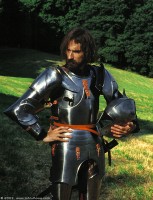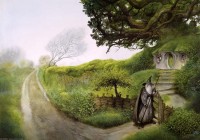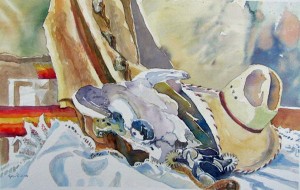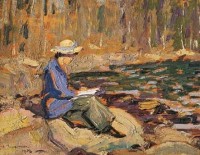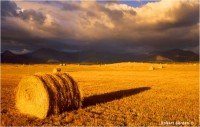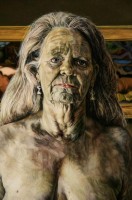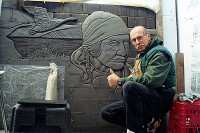Archive for the ‘Art Exposure’ Category
John Howe is a Vancouver born illustrator, now living in Switzerland, known widely for his renderings of the Lord of The Rings canon and movie trilogy series. He also happens to be my favourite artist. Born in 1957, Howe attended primary and high school in Vancouver, but one year after graduation, he enrolled at the Ecoledes Arts Décoratifs in France.
For years, Howe had been drawing and painting scenes from J.R.R. Tolkien’s epic history of Middle-earth. Most of these can be found in his online portfolio categorized into The Silmarillion, The Hobbit, and The Lord of The Rings books. Other works can also be found online as well, including cover art for books and novels, rough sketches, unpublished work, and loads more. Howe’s website also contains a few tutorials, such as how to paint grass, what kinds of brushes to use to achieve a desired outcome, and how having drawers full of rocks is a good thing for any illustrator.
Going beyond art, Howe puts some serious thought into his paintings, as can be seen and read on his website, and even in the special feature DVD’s of The Lord of The Rings. On his website, Howe tries to render many medieval objects that do not necessarily exist today as part of his artistic planning process. He recreates many artifacts, such as a sword, to understand the weight, motion of the swing, the muscles needed to swing it, etc. Only after this can one properly understand how to render it. As a result, there are photos found on his website of Howe wearing suits of armour and wielding swords.
Many artists begin showing an interest in art as very young children: Roberta Murray is no different. In fact, her mother wrote in her baby book, “very artistically able from the age of two”. This Calgary born photographer recently joined the Alberta Society of Artists, and has photographs on display in galleries worldwide.

Roberta Murray
Roberta completed the New York Institute of Photography’s certificate program in 1990, but sold all of her photography equipment shortly after to shift her focus to textiles. After fourteen years of textile work Roberta returned to photography at first to document her textile work, and later as a form of meditation. Fortunately for all of us, this long break from photography led Roberta to discover new ways to think about colour and detail, and resulted in the impressionistic pictorialist style she is known for today.
The photography of this Rocky Mountain House Resident is truly striking, almost having a closer resemblance to paintings than photos. I strongly encourage everyone to take a good look at her portfolio to take in this very unique style.

Joan Bailey - Image from ArtistsinCanada
Alberta artist Joan Bailey boasts an almost entirely self-directed art education, and as a result she has skillfully created a very diverse collection of art using paint, wax, and metal. Because of the variety in her art her online portfolio is much more interesting to peruse than many of the artists I investigated for this edition of Art Exposure. Bailey claims to thrive on exploring the patterns and mysteries of life through the use of stark contrast in her art, which was very apparent as I explored the works on her website.
The reason I chose to feature Joan this week is because of the variety in her work. Although I am by no means knowledgeable about art, I have noticed that many artists tend to specialize in one form of art (even if they do explore a variety of mediums as well). She doesn’t appear to focus on any one form of creation more than any other, which pretty much made her perfect for Art Exposure, in my opinion.
Joan has an email provided on her website for those who are curious about pricing or other aspects of her work.
Gena LaCoste is a local Medicine Hat artist with a lot of “pull” around town in the art community. I personally see her work in many places in town and also see her participating in pretty much every art event happening in the city, and sometimes even some trade shows/markets. She definitely is one of the biggest names in Medicine Hat, especially for her stylistically vivid and colorful large format watercolor paintings. She tends to deal with subjects ranging from horses, floral themes, to other prairie life depictions – what she knows and has lived.
Her website is full of her artwork with three separate galleries packed with tons of her paintings over the years, listing the names, the price (if they are for sale), and even where they currently are showcased. The site also contains a sizable biography on Gena, here’s a snippet:
Gena LaCoste paints what she loves. Gena has loved the grasslands from her first breath. She learned about the land and its unique ecosystems from her family, and this love has equipped her to paint the authentic lifestyles of prairie families. Now, Gena paints what she loves. “I was painting and drawing by the time I was three years of age,” Gena recalls. “My early memories include the river at the cow camps, and the sounds of water sliding past. Dust, heat rising, the arid smells of sage brush, and the tones of light begged to be painted.” Riding on her own horse to the cow camp with her father, for instance, etched images in her heart that she tries to record through colours and water. “I remember trying to find a way to draw a horse so that it looked like the ones in front of me.”
The Group of Seven were a group of Canadian landscape painters that was highly influenced by European impressionism. They banded together in the 1920’s to tackle the enormous task of painting lansdcapes in Canada, primarily around Ontario. At the time the landscapes were thought to be either unpaintable or unworthy of being painted. Initially the reception of their artwork was indifferent, but as time went on, they became recognized as pioneering artists in Canada.
The logic behind believing that some Canadian landscapes were unpaintable was largely due to the fact that the scenery around Ontario was so full of trees and hills that anything painted would inevitably end up looking like a large blur of paint. As pioneers, the Group of Seven developed techniques, which were frequently based on Impressionism, to create their art. Some of them had formal training as painters or designers, which can sometimes be seen in their art.
Later in the Group of Seven’s career, they expanded across Canada to gain inspiration and paint what they saw. They even ventured so far as the Arctic, where they became the first artists of European descent to portray the wintry landscapes in art.
The Group gained a few members over the years, becoming more like a Group of Ten, and by 1931, their influence had spread so far that there was no longer a need to be a ‘Group’. They disbanded, and later formed the Canadian Group of Painters in 1933, and now we are living in their legacy.
Prints can be ordered from the expansive gallery on the Group of Seven website. http://www.groupofsevenart.com/
Although Robert Berdan worked as a Cell Biologist at the Universities of Alberta and Calgary for twelve years, then managed the Calgary Science Centre for five years, he has also been well-known photographer for thirty years and owns a web design company in Calgary. Cell biology seems a strange career path for such an creative person, but the variety in his work life most likely made his photography and design much better.
Berdan’s photos have been published in science journals, book covers, and IMPACT magazine, and have even been a part of a traveling exhibit with the Science Centre. Robert prefers to print his own photos using an inkjet printer that produces the astounding detail he is known for. The primary focus of Berdan’s photos is nature, and all animals that appear in his photos are wild, rather than captive or rehabilitated. I like that detail the most, I think. Every time I see footage of “wild” animals I think of a video I once saw of David Attenborough stumbling through a forest searching for a species of bird, that is so rarely seen… in an Australian zoo (so disappointing). Needless to say, it is quite impressive that Robert is committed to taking pictures of animals in their natural habitats. All of Berdan’s photos have been taken in either Southern Alberta or Georgian Bay, Ontario. Presumably the quality of the picture I posted here was not compromised by being viewed on a monitor as the only modifications done on them are those that would be done in a dark room (burning, dodging, dust spot removal, and colour enhancement through the use of masks).
In addition to his photography, Robert owns a small design company called Science and Art Media in Calgary. Apparently, Robert was the first person in Calgary to offer internet training in Calgary. so much for the stereotype of older adults being inept at learning internet skills. I am going to leave the commentary on the quality of the designs up to the two designers that run this site since I’m sure they will pounce on it as soon as they read this.
For those of you who are wondering about the Attenborough reference I have included the video to which I am referring, it is very cool even if it is in a zoo.
In this issue of Art Exposure I will be talking about Dean Smale – a Medicine Hat based musician, artist, and teacher for the Visual Communications course at the Medicine Hat College.
Dean is undoubtedly an amazing painter. His paintings are highly realistic, going so far as to depict the flow of blood under the papery skin of an elderly subject in some cases. They say that you cannot paint every leaf on a tree, but Dean only takes that statement as a challenge. Many of the subjects of his paintings are rendered in the nude, or are elderly, but in many cases both. His painting style involves building up textures, light, and shadows by using many layers of paint: undoubtedly a lengthy process.
In Dean’s paintings only by peering deep into his work can all the connections be made. For instance, in the portrait to the side, the woman’s earrings are hourglasses that have run out; a symbol of her age.
His illustrations are often amusing, but if you lack a modern or youthful sense of humour, they will just seem very perverse. Similar to his paintings close observation of Dean’s illustrations is required to see what is going on, since body parts can be so easily disguised.
His exhibits can often be seen in Medicine Hat, but are frequently in cities such as Edmonton and Calgary. Dean’s work has even be seen in American galleries.
As a teacher, Dean encourages his students to produce good work at any cost. In one instance he went so far as to tell me that I should quit my job and rob a bank, all in an effort to spend more time creating art. I am pretty sure he was joking… or was he?
In addition to visual arts, Dean is also an accomplished guitarist. It is not unusual to see him perform at Visual Communications art shows. I have heard his style of playing described as “Way the f- out there! I don’t even know what to call it!”
Check out the galleries after the jump:
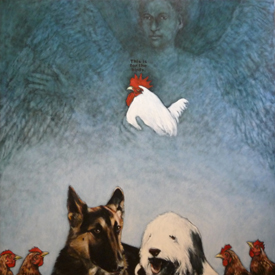
The Chicken Angel, oil on panel, 2009, 122 x 122 cm
Already mentioned a lot on this site is this week’s art exposure topic: Maureen Newton.
Maureen Newton, owner of Inspire Studio & Gallery, was born and raised in Medicine Hat. If you have seen her talk at all, usually at one of her receptions, she usually tells bits and pieces of growing up and how art took a part in her life very early on and stuck there all throughout her life. She started her art education watching her father, who was also an artist. She spent many hours watching him drawing and painting.
Although she is quite focused on oil painting as seen by her latest reception, “This is for the Birds” which ran at the Esplanade during Alberta Art Days she actually originally received a Bachelor of Fine Arts from the University of Lethbridge in 1986 majoring in printmaking as well as painting. Her artwork has been displayed locally at the Cultural Centre Gallery and nationally in Vancouver, Kingston, and Toronto. You can also spot some of her work in the Medicine Hat College Vera Bracken Library.
Inspire Studio & Gallery acts as a place to showcase her work as well as many other local artist’s works. It also doubles as her work space where she paints and creates her art.
David Carter is an author who was born in Moose Jaw, Saskatchewan in 1934 and has traveled all around Canada during his years. He has written 15 books and has been involved in many historical journals throughout the prairies. Along with this, he has provided research materials, probably based on his books, to a myriad of TV productions, including:
- Murder Behind The Wire for CBC
- The Enemy Within for the National Film Board of Canada
- Hitler’s Canadian’s for History Television
Some of his books are related to Canada’s history. One book in particular, entitled POW – Behind Canadian Barbed Wire, describes how Canada operated Prisoner of War camps during the First World War, in which many of the people who did not possess a Canadian citizenship and/or were judged to be a threat to the British Empire were ’rounded up’ and put into camps. Sounds kind of like Nazi Germany. The book was originally published in 1998, but since 2004 now includes black and white photos.
More about David Carter can be viewed on his website
Unless you are a complete shut-in, everyone in Medicine Hat should be familiar with the elaborate brick murals that are scattered across the city. From the downtown Dairy Queen to Herald School to City Hall, James Marshall’s impressive artwork has been thrilling the eyes since the early 1980s.
Marshall was born and raised in the Hat, and his family has lived here since the 1800s. With a love of art that developed during childhood with the help of his father and school art teachers, Marshall became one of the most prominent artistic forces Southern Alberta has to offer. But before he began sculpting brick, James was most well known for his pen and ink drawings of Albertan historical sites. After starting Grassroots Studios with his wife, Lorine, the couple were commissioned to create pottery, small sculpture, and historical drawings. Thanks to the Saamis Rotary Club Marshall had the chance to create his first brick mural, “Saamis the Legend”. After being commissioned for a mural in Ontario, Marshall was recognized in an architectural magazine allowing his career to skyrocket: the rest is history.
The physical exertion of creating murals has forced Marshall to slow down, but he continues to be involved in the community by raising awareness of the historical wealth of this area. His efforts to save the numerous historical sites Medicine Hat has to offer will ensure that his impact on this community will last as long as the murals he has created.
You are currently browsing the archives for the Art Exposure category.

